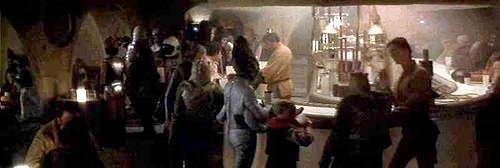CineSecrets.com


Star Wars memoirs
from someone who was actually there!
Nick Maley’s


If anyone deserves a BAFTA Lifetime Achievement Award for his contribution to innovation in make-up and creature effects it has to be Stuart Freeborn. There are several other worthy contenders for this honor but this feisty little man from Beckenham, Kent, who could have doubled for his most famous creation, Yoda (Star Wars), overcame all odds to become a giant of the British film industry.
A tribute to Stuart Freeborn
7/19/09
It was my privilege to work with Stu, on and off, for 7 years. I first met him at a union meeting in 1969. Stuart's work on the apes for Kubrick's 2001 was still very fresh in my mind. At that point in time, BEFORE the wonderful Rick Baker ape suits, before "movie animatronics" were even conceptualized, we had seen nothing in cinema that came even close to the realism Stu and his team had achieved. Although the Academy of Motion Picture Arts wrestled for over a decade with categorizing such work, in the minds of those of us who aspired to create special effects make-up, 2001 - A Space Odyssey catapulted Stuart from "distinguished artist" to "deity". As a new kid on the block, I really wanted to be noticed by this often jovial but intimidating personality. After 2 years, he finally offered me 2 days work on Young Winston. Those 2 days lead to 16 weeks and spawned a very special friendship with Stuart's son Graham that lasted until his untimely death in the late 80's.
Over the years Stu told me many stories about his early days. I remember particularly, celebrating Stuart's 40th anniversary in movies with him and Graham at an apartment block that Stu and wife Kay owned in Islworth. There he showed me masks and memorabilia from 2001 and we chatted about how he struggled to break into film.
Born 5 September 1914 in England, Stuart grew to be a young man with a dream of working in movies. Whilst still an amateur, he spent many hours polishing his make-up skills... on himself... and photographing the results. Because he had no direct contact with anyone in movies most of his techniques were self-taught but still he sent photos of his creations to the leading film make-up artists of the day hoping that someone might notice his potential. Unfortunately. He received NO responses. He even tried on several occasions to sneak into the studios but all his efforts to demonstrate his skills seemed blocked at every turn.
In 1935 he made a bold move. The Times newspaper received reports that Emperor Haile Selassie had been sighted driving in Beckenham. After political and public questioning on how a foreign dignitary could be in the UK unbeknown to authorities, the truth "leaked" out. The "Emperor" was in fact Stuart with nose, beard and make-up attached. Unfortunately, rather than attaining the admiration that the work deserved, he was temporarily detained for questioning by the local police. Despite the publicity Stuart's career might have ended right there as not one of the make-up artists Stu had previously contacted were impressed enough to offer him a job. Undaunted he sent the newspaper clips and photos of his work direct to Alexander Korda who controlled Denham Studios and to his delight was summoned to the studio. There he was asked to repeat one of the make-ups in his photos. Nervously he set about the task and once finished he was lead off to put the results on film. To his surprise, he found himself on the set of Rembrandt which starred the incomparable Charles Laughton. The resulting screen test won Stuart a job and he finally met some of the make-up artists he had written to. He had dreamt of working alongside these professionals, "learning the tricks of the trade". However, he says, "I suddenly realized that they hadn't responded because they knew less than me!"
His first on screen make-up was on the beautiful Annabeila for Wings of the Morning in 1936. It was the first Technicolor movie ever made and required everyone to be painted gray to avoid appearing magenta. Stu went on to contribute to film after film, including The Thief of Baghdad and Victoria the Great. For ten years Stuart worked on numerous projects at Denham. Usually uncredited. It was the tradition in those days only to provide credits for the head of each department. (I worked with Stu for 5 years before getting a film credit).

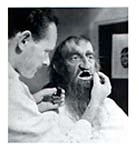
"Some people felt the enlarged nose was racist", Stuart confesses. "But the studio wanted a look similar to cartoon illustrations that had accompanied the book. I tested two different versions. One with a realistic nose and one heavily exaggerated. At the test screening Lean put it to the vote and everybody chose the exaggerated one," Stuart laments. He felt he had no choice but to do it that way. To this day he regrets that so many people were offended by it. In New York, the performance was denounced as anti-Semitic, and the film remained unscreened until 1951.
Despite the fuss, the notoriety established Stuart as an extraordinary talent and he continued to work frequently on movies like The Story of Robin Hood and His Merrie men and The Dam Busters, sometimes making 3 or 4 films a year.
In 1954 he was signed up to do His Majesty O'Keefe starring Burt Lancaster and looked forward to creating various looks for the Hollywood superstar as the character journeyed through Polynesia and devolved from businessman to sea dog. But the tough mannered Lancaster had other ideas. He obviously thought that filming in England would involve dealing with second rate technicians and presented Stuart with preconceived make-up designs done by the renowned Bud Westmore.
"This is how we do it in Hollywood", Lancaster said, towering over the little make-up man from Beckenham.
"Yes", said the feisty British bulldog as he presented his own designs, "...and this is how we are going to do it in England!"
Lancaster admired his spunk, "I like you." he smiled. And so, Stuart got his way and the two became good friends.
In 1957 Stuart's career was almost ended by a car accident while filming another David Lean movie... The Bridge on the River Kwai . The car in which Stuart was a passenger was struck by a truck on a jungle road in Sri Lanka as the crew returned to the hotel after a days filming. The others in the car all died but Stu was thrown 15 feet off the road where he hit a tree.
"I lay there semi conscious for 4 hours". He recalls. I heard the rescuers but I couldn't speak and they didn't find me in the bush". It was several hours before it was realized that he was still missing and they returned for him. Stuart spent 4 months in hospital recovering. Undaunted, he was back to work soon after convalescing.
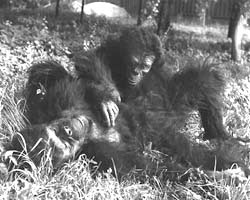
Over the years that I assisted Stu, he told me many hilarious stories about 2001. I wish I could recall all the details. They started out with the concept of Neanderthal type prosthetic make-ups for "The Dawn of Man" sequence and Kubrick even advertised in The Times that they were holding auditions for short men with long arms!
"We got all shapes and sizes of wannabe actors," Stu recalled, "...often bending their knees in the hope of make their arms look longer."
Eventually they shot a series of make-up tests, (Kubrick LOVED tests as I found out years later when I helped out on The Shinning), but none proved to be what they really needed and the concept was ultimately abandoned over issues of exposed genitalia. Simply put, the Neanderthal types were a lot less hairy than the final ape suits and there was little to cover their private parts.
Arther C. Clark recalls, ( at http://www.visual-memory.co.uk/amk/doc/0099.html) "Kubrick realized straight away that this was not going to work. For obvious reasons, it would be necessary to show the characters with at least some minimal clothing. However, any form of clothing only became possible with the advent of some form of tools and the ability to create or manufacture the necessary materials. One of the main points of the Dawn of Man was to show that ancient humans had no concept of any such technology until the intervention of the monolith.
Some consideration was given to "above the waist" filming; another idea was to use some kind of concealing material applied to those awkward but necessary features of the human body. Either of these would have made the whole thing look ridiculous; hence the decision to move the sequence back in time to a point where clothing and decency would no longer be issues.
Of course, this made the job of make-up far more complicated, but Kubrick hired only the best people, and Stuart Freeborn's costumes, as donned by Daniel Richter's mime actors, were a major factor in creating the most convincing scenes ever filmed of the distant past.
To my fury, at the 1969 Academy Awards a special Oscar was presented for makeup to Planet of the Apes! I wondered, as loudly as possible, whether the judges had passed over 2001 they thought we used real apes."
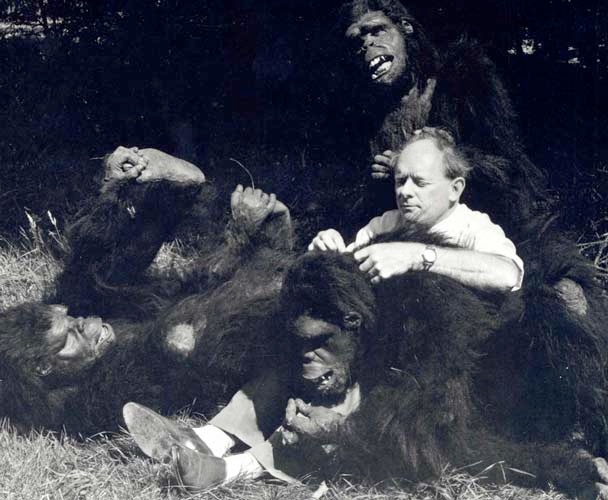
These last words are undoubtedly responsible for the widely held belief that the Academy thought Kubrick had used real apes. But the real reason Chambers got the Oscar over Stuart was that the Academy was not sure that men in suits and the soft mechanics we now refer to as animatronics should be classified as make-up... even when done within the make-up department. It was a debate that lasted a decade and finally found acceptance with Rick Baker's ground breaking transformation in American Werewolf in London.
During those days with Stuart and Graham in Isleworth, after Star Wars, before Spectre, he allowed me the opportunity to examine several of the 2001 ape masks. The brilliance in the concept was not the simian teeth as some have reported, nor was it that they were mounted on a lightweight skull, (PERFECTLY molded the performer's face). It was that Stuart generated movement in the foam skins directly from the actor's face below. The jaw of each mask pivoted directly over the actor's jaw pivot allowed the ape's jaw to move as the actor's did. But better still was that he included a mechanism that AUTOMATICALLY curled the apes lips as the jaw opened and added a false tongue operated by the actor's own tongue. Ape lips, made by Stuart and his team, drew back to reveal realistic teeth and tongues that licked real flies off the meat they ate. The combination was astonishing for that time.
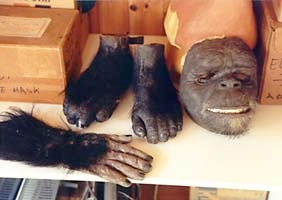
The body suits were made by knotting human hair, yak hair and horse hair onto a knitted woolen garment. It utilized the basic techniques used in wig making but applied on a much larger scale. The garment was similar to a hand knitted jersey and the hairs were individually tied through the loose weave. Foam latex was incorporated where the hair grew thin and hands and heads were separate. In the foam areas Stuart pioneered "hair punching" by inserting individual hairs into the foam pieces with a hypodermic needle. Eventually this evolved into a system using bails of nylon of different colors and multiple needles to achieve the speed needed for production deadlines.
Although the film also included complex aging prosthetics it was the apes that fired the imagination of the public and assured Stuart's place in movie history.
The link between the apes of A Space Odyssey and the creatures of Star Wars is so close that one is tempted to jump on 7 years. But between the two there were other projects such as Sir Richard Attenborough's Oh! What a Lovely War, 10 Rillington Place and Young Winston where I first joined Stuart's team. Quick to follow were Inside the Third Reich, plus the huge prosthetic endeavor Alice's Adventures in Wonderland, more characters for Peter Sellers in Soft Beds, Hard Battles, a gelaten aging for Murder on the Orient Express, followed by The Adventure of Sherlock Holmes' Smarter Brother and the spooky thriller The Omen.
On The Omen Stuart focused on Gregory Peck and the movies highly realistic dog puppets. The acclaimed severed head of David Warner was made of dental acrylic by Stu's son Graham who later used the same techniques to create heads and severed hands for Star Wars' Luke and Vader.
The bar scene from Star Wars included my first on screen prosthetics. Although I had helped Stu with make-ups for Young Winston, Soft Beds & Hard Battles and others, it was Graham's influence that finally involved me in a creature effects crew. More than ever Stuart was the strict taskmaster casting a quizzical eye over all that was produced. Chewbacca was VERY closely aligned to the apes from 2001 . Stuart focused mainly on Chewie while Graham, Charlie Parker, Chris Tucker and I made characters for the cantina with help from Kay and others of the on set make-up crew. There was almost no direction from George Lucas on how those creatures looked. Stuart was the sole authority in that regard. Those of you who have read my pages on that time will not be surprised by the fact that so few of us only had 12 weeks to prepare for such a classic scene. In that light it is understandable why, as the post production edit heralded the potential of a huge success, Rick Baker was asked to create additional aliens for inserts to pad out the original footage. He too did an outstanding job. Both he and Stuart won the Saturn Award in 1978 for Best Make-Up.
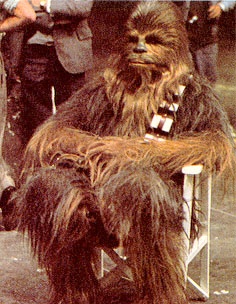
The foam skin which Graham and I foamed was designed to fit perfectly over a fiberglass skull filled with rigid polyurethane. The interior of the skull was a prefect fit to Peter's face. Talc was used as a non-greasy lubricant to aid the skin's movement over the skull. Teeth were acrylic and permanently fixed into the skull. Numerous toggles around the mouth, eyes and nose transferred Peter's facial movement to the skin of the mask above.
The entire costume weighed 15-20 pounds. Although several versions were built for different movies as the suit had a habit of molting in hot weather the design was never altered.
Right after Star Wars, Graham, Kay and I helped Stu with a TV pilot for Treckie Producer Gene Rodenbury called Spectre. Star Wars had such a long post production that Spectre was shown before the classic trilogy was launched. Staring Gig Young and John Hurt assorted creature effects were based around a story of demons and possession that failed to inspire a series.
We also assisted Stuart on Superman I and the Dick Donner sections of Superman II. Stuart supervised the make-up on all of the Salkind Superman movies. He designed Superman and Clark Kent as two quite separate people, parting Clark Kent's hair on the right and Superman's on the left. A set of prosthetic chest muscles built for Christopher Reeve proved unnecessary after he pursued weight training and were only used once... by Graham and myself when we went to the Pinewood Studio bar! However, Fiberglass shells the shape of Chris' torso were used most innovatively to support him on many flying sequences filmed against blue screen. Stuart's unique adaptation of front projection techniques applied to the dummy superman absorbing an atomic blast earned him a credit for Special Optical Effects.
In 1978 we started The Empire Strikes Back. The crew was still small. Stuart was assisted by Graham, myself and 3 apprentices (including Nick Dudman who later built the creatures for Episode I). Of course Kay was always around too, flitting to and from the set where she cared for Carrie Fisher, Chewbacca and others.
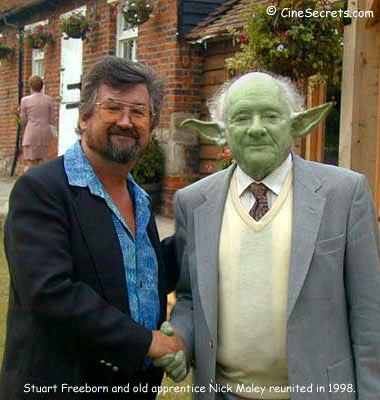
When we met again in 1998, 20 years had passed. He was 85 and the likeness to his famous creation was uncanny.
More than any other movie of the time, Empire merged puppets, robotics, stop motion and physical effects in a way that crossed union boundaries and resulted in a decade of confused credits. As George Lucas allowed extra time for creature development, the stage was set for the birth of movie animatronics. Make-up effects strayed into puppetry and Muppetry evolved to include engineers and animators. It was an exciting time to be in movies and Stuart's concepts were a catalyst for much of that development.
After Empire Stuart returned to complete Superman II with Dick Lester. I moved on to design for other movies and Nick Dudman moved up to join Graham as Stuart's main effects assistants.
In 1980 Stuart's association with the Muppets lead to him overseeing the make-up for The Great Muppet Caper and in 1981 he went on to the third Superman movie. Returning to the concept of integrating front projection material into his make-up effects, Stuart combined 3M reflective beads with chrome paint and silvered contact lenses to create "Vera", a robot make-up on actress Annie Ross. The design was loosely based around Maria from Fritz Lang's 'Metropolis, but the unique adaptation proved to be truly startling.
In 1982 Stuart started on Return of the Jedi. As technical boundaries merged and creatures became more complex, Stuart's crew once again expanded to the size of 2001 - A Space Odyssey. Veteran effects make-up artist Tom Smith (who later headed The Shining and Indiana Jones and the Lost Arc) came onboard, as did Danny Parker, (Charlie's son), and Bob Keen evolved from apprentice to a key mechie for creatures such as Jabba the Hutt. The scene in Jabba's Palace became a riot of humorous creature effects which far surpassed the technical achievements of the original cantina scene and only failed to overshadow it because such scenes had come to be expected as part of the soup that was the classic trilogy.
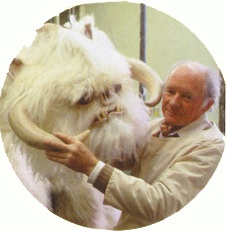
Stuart followed Jedi with the comic prosthetics of Top Secret!, then King David, Santa Claus, Haunted Honeymoon and Superman IV.
I believe Stuart's last movie was Max and Helen in 1990. It marked the end of a career that spanned an incredible 7 decades and carved out a unique place in movie history. For those of us privileged to be a part of his team he will be remembered as a demanding mentor who strictly maintained discipline and always kept us on our toes. Of course there were gentle moments of insight and humor but Stu was always acutely focused on achieving his goals. He could be a hard man and was not always liked. But he always aroused our eagerness to live up to his expectations as he fashioned a distinguished career that demanded our highest respect. There is no doubt in my mind that the years I spent assisting him changed my life drastically. My own comparatively insignificant movie career, (a meager 18 years), was founded entirely upon the concepts that working with Stuart motivated in me. Simply by association he inspired us to find lateral solutions to conventional problems through original and creative thinking.
Undoubtedly the leading British make-up artist of the 20th Century, he has left a HUGE pair of shoes that will be very hard to fill.
